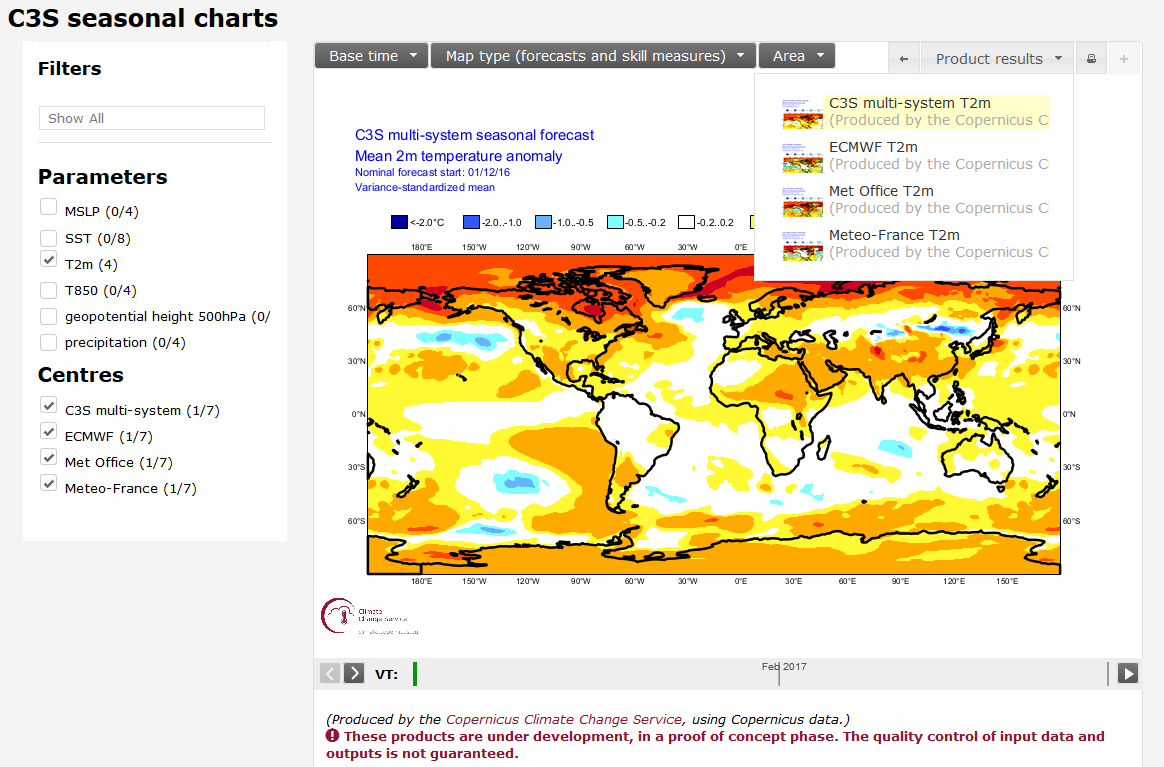The EU-funded Copernicus Climate Change Service (C3S) operated by ECMWF has begun to trial a prototype seasonal forecast service on its website. The aim of the service is to generate seasonal forecast products based on the best information available, to an operational schedule, and to make them publicly available.

The seasonal forecast service is based on a multi-system framework. Data is collected from several European centres which either already have well-established activities in seasonal forecasting (core providers) or are committed to developing and implementing such systems into operations over the next year (additional providers). The core providers – ECMWF, the UK Met Office and Météo-France – have been delivering data to C3S for the last few months. A suite of products has been implemented at ECMWF to process this data into forecast products of relevance to users. The additional providers – CMCC (Italy’s Euro-Mediterranean Center on Climate Change) and DWD (Germany’s National Meteorological Service) – will start submitting data for inclusion in the product suite in the course of 2017.
Staged implementation
As the driving principle behind the seasonal forecast service is relevance to users, the service will be developed and implemented in several stages. To begin with, products with which users of seasonal forecasts are already familiar have been created and published. Feedback on these initial releases will be used alongside information collected in separate, independent user requirement-gathering activities to refine and enhance the portfolio of products. To allow access to the prototype service as early as possible, the initial releases come with a limited amount of documentation and information on the quality of the products. During the trial period, we recommend using the contributing institutions' own documentation for supporting information. In the next release C3S will calculate and display skill information for the suite of products provided.
The initial release consists of deterministic and probabilistic forecasts for sea-surface, near-surface air and upper air (850 hPa) temperature, geopotential height (500 hPa), mean sea level pressure and precipitation. The forecasts provide seasonal (three-month) means and have a range of six months. They can be viewed both for the multi-system combination and the individual contributions (the comparison of the single-system forecasts can give an indication of uncertainty in the forecast). The products are released on the 15th day of each month. The product list offers links to maps or time series for the forecast variables and the facility to navigate to the full set of graphics.
Future updates to the product portfolio will add new variables, monthly-mean estimates and associated skill information, and new indices and forecast products (e.g. climagrams). A data service is also under development. It will allow users to download both the original data the graphical products are based on and post-processed data. More details on the implementation of the service and access to the initial-release products are available at http://climate.copernicus.eu/seasonal-forecasts.
C3S and EUROSIP
Readers familiar with EUROSIP, a multi-system seasonal forecast activity coordinated by ECMWF since 2005, may wonder how these two activities relate to each other. While both aim to put into practice the multi-model approach, whose benefits have been explored in research projects like DEMETER and ENSEMBLES, their scope is rather different. C3S is aimed at a larger audience and has an open data policy. EUROSIP data, which is archived at ECMWF, can be accessed subject to the terms of the more restrictive EUROSIP data policy.
The partners involved are also different. The three core C3S providers are all partners in EUROSIP, but EUROSIP also includes NCEP (the US National Centers for Environmental Prediction) and JMA (Japan Meteorological Agency) as associated partners. At the same time, as described above, C3S actively supports the development and implementation into operations of new seasonal forecasting systems in two European centres. Their output will be included in the forecast products offered by the service.
As it stands, the two state-of-the-art forecasting systems from the associated partners in EUROSIP are absent from the C3S multi-system. At their next meeting, in early 2017, the EUROSIP steering group will discuss options for a transition to a well-resourced, operational C3S multi-system seasonal service.

